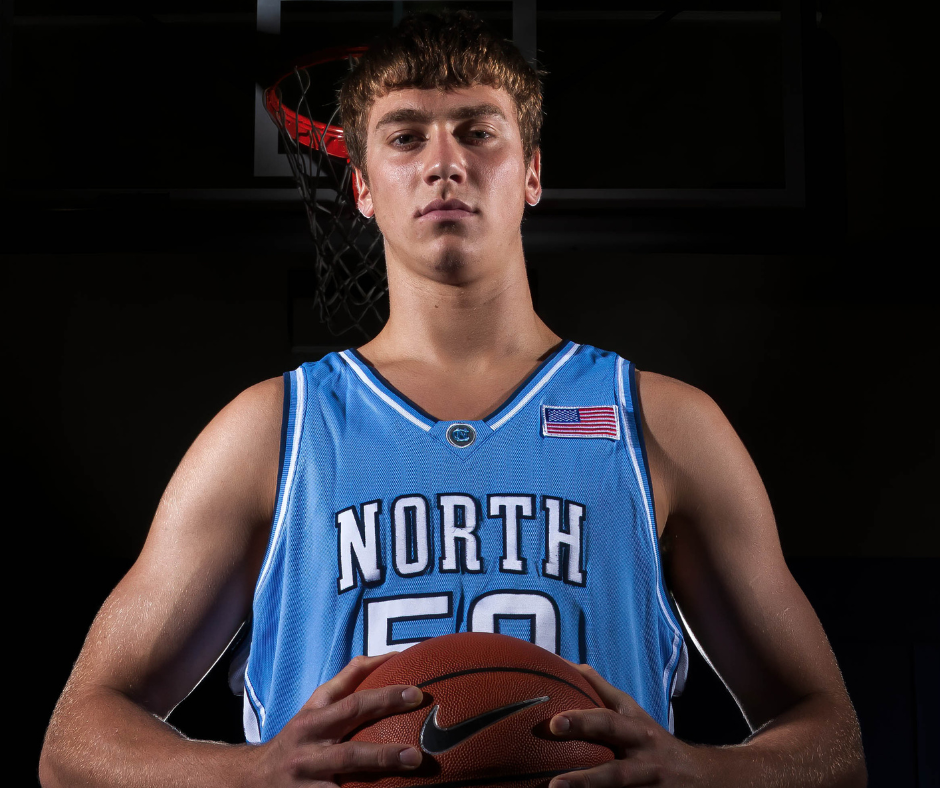The lights drop in the Dean Dome, and you can almost hear Dean Smith’s voice echo through the rafters: “Play hard. Play smart. Play together.” The Carolina blue glow washes over decades of greatness: Michael, James, Phil, Vince, and the ghost of Roy pacing the sideline like he’s still coaching every possession. In Chapel Hill, basketball is more than a pastime. It’s legacy and history that raises the bar.
Cue the band, cue the powder blue warmups, cue the jump ball between eras. We’re highlighting the best starting five ever to wear the uniform, no matter the version. Here is Dean’s Dream Team, the all-time North Carolina starting five.
Point Guard – Phil Ford (1974–78)
If the Tar Heel system had a soul, it would be Phil Ford. Smith’s four corners offense was built around his poise and precision. Ford didn’t just run point; he defined Carolina tempo. He was the 1978 Wooden Award winner, a consensus All-American, and the first college guard to average more than 18.6 points and 6.1 assists across four seasons. His pull-up jumper and command of the floor were surgical. In the pre-shot clock era, Ford’s decision-making made him a one-man metronome: calm, confident, clinical.
Why Ford over Ty Lawson or Joel Berry? Lawson was jet fuel, Berry was pure heart, but Ford was orchestral genius, the metronome that made Dean’s symphony sing.
Shooting Guard – Michael Jordan (1981–84)
Sometimes history doesn’t leave room for debate. Jordan was more than “The Shot” in the 1982 title game. He was the young phenom who merged Smith’s structure with raw improvisation. He averaged 17.7 points per game over three seasons and left UNC with a national title, Naismith and Wooden Awards, and the single greatest alumni résumé in basketball. College MJ wasn’t yet “Air,” but you saw the prototype every time he broke baseline or stared down Patrick Ewing in the post.
I’m from Chicago and watched the madness of MJ through all six NBA championships. I may have missed his college greatness, but MJ will always be the greatest in this sportswriter’s book. And for those who enjoy sports historical fiction films, check out Air and the making of a brand and career that set NIL in motion.
In this lineup, Jordan’s the off-ball killer, curling off screens, catching from Ford, and finishing over anyone brave enough to help.
Small Forward – Vince Carter (1995–98)
In Carolina mythology, Vince Carter is the bridge between eras, Dean Smith’s final act and Bill Guthridge’s link to the new age. Carter was electricity with touch. He averaged 12.3 points and 6 boards while redefining above-the-rim play. But what made him indispensable wasn’t the dunk show; it was his versatility: defend 1 through 4, shoot 40 percent from three, and make the extra pass.
When you’re building an all-time Tar Heel five, you need balance. Carter brings the showmanship that made fans fall out of their seats and the defensive bite that earned respect from purists.
Power Forward – James Worthy (1979–82)
“Big Game James” was the alpha before MJ became Air. The 1982 NCAA Final Four Most Outstanding Player averaged 15.6 points and 6 rebounds for his career and delivered 28 points in the title game against Georgetown, the night Jordan hit that shot. Worthy was the prototype hybrid forward with smooth post moves, a perfect midrange game, and elite speed in transition.
If you want to run Smith’s classic secondary break to perfection, Worthy is your lane-runner supreme.
Center – Tyler Hansbrough (2005–09)
You can argue for Sam Perkins. You can make a case for Brad Daugherty. But if Carolina basketball has a heartbeat, it’s named Psycho T. Hansbrough is the all-time leading scorer in UNC history (2,872 points), four-time First Team All-American, and 2008 National Player of the Year. His motor was unrelenting, his toughness unmatched, his face permanently smeared with sweat and Carolina grit. He was the player every opponent hated and every Tar Heel loved because he never took a play off.
In this lineup, Hansbrough’s rebounding and relentlessness let Ford and Jordan run. He’s the muscle that turns pretty basketball into winning basketball.
Sixth Man — Antawn Jamison (1995–98)
Jamison gets the sixth-man nod for being the quiet killer. His quick-release scoring and efficiency, 22.2 points per game as a junior on 58 percent shooting, earned him National Player of the Year honors. He’s instant offense off the bench, and if you swap him in for Carter, the lineup morphs from highlight reel to clinic.
The Dean of Them All: Dean Smith’s Legacy
If this all-time five needed a coach, there’s no debate; it’s Dean Smith at the helm. The man who turned Carolina blue into a brand of basketball purity built his program on discipline, innovation, and humanity. In 36 seasons (1961–1997), Smith went 879–254 (.776), winning two NCAA championships (1982, 1993), 11 Final Fours, 17 ACC regular season titles, and 13 ACC Tournament crowns. He retired as the winningest coach in Division I history, and while his numbers may have been surpassed, his influence and presence never fell from first place in the hearts of Tar Heels fans.
Smith taught the four corners offense before the shot clock existed, made pointing to the passer a Carolina tradition, and turned his program into a finishing school for both NBA legends and good men. From Jordan and Worthy to Ford and Perkins, his players carried his calm authority and relentless preparation into every game and generation.
When we call this lineup the Dean’s Dream Team, we mean it literally. His fingerprints are on every era of Carolina greatness and many would say still define the Carolina Way.
How They’d Play — Dean’s Blueprint, Roy’s Pace
Imagine this team running the Carolina break: Ford leading, Jordan and Carter on the wings, Worthy trailing, Hansbrough sprinting the lane. The floor balance is textbook, the options endless. Ford slows tempo when needed, Jordan and Carter feast on mismatches, Worthy stretches defenses with his short corner jumper, and Hansbrough cleans every glass.
Defensively, they switch 2 through 4, funneling everything to Hansbrough’s physicality. It’s the best of Smith’s discipline and Williams’ chaos.
Betting Corner: Futures on the Current Tar Heels
If you want to bet on the modern Carolina squad while we debate ghosts of Chapel Hill past, here’s how the 2026 NCAA Men’s Basketball futures stack up today (checked Oct. 28, 2025, 11:00 a.m. ET):
FanDuel lists North Carolina at +1800 to win the 2026 NCAA Championship.
DraftKings has UNC at +2000 in the “Men’s NCAA Tournament Winner” market.
The Tar Heels are sitting in that sweet spot: enough history, enough hype, and just enough veteran leadership to make the smart money linger.
Want more Sandman? Come connect with us here at sandmansports.com/onestopshop




